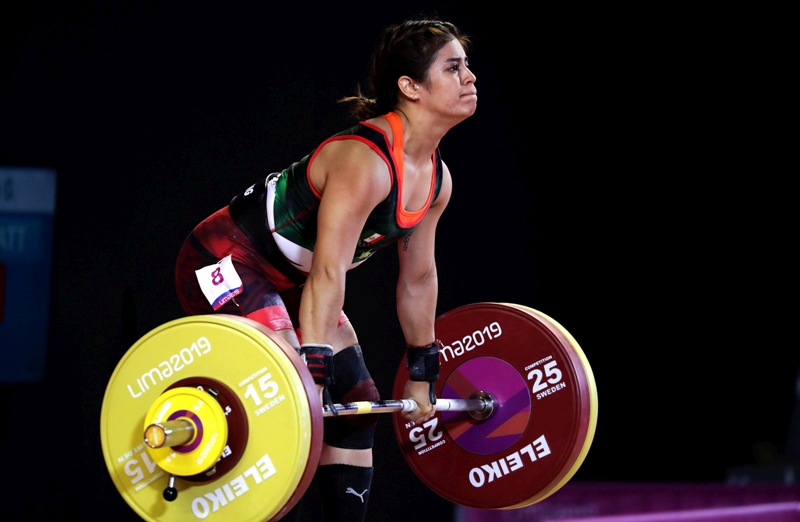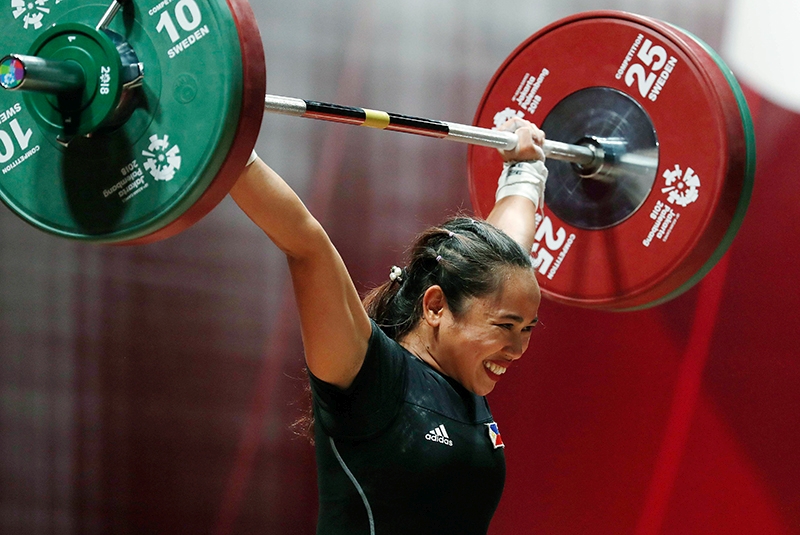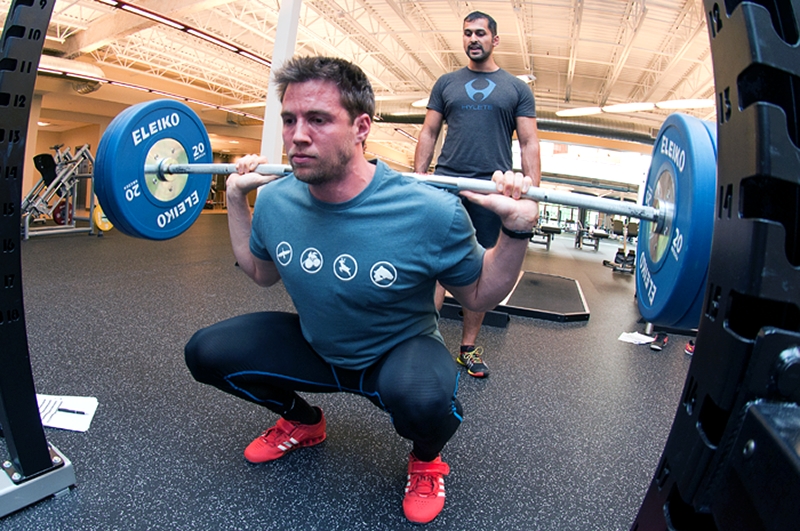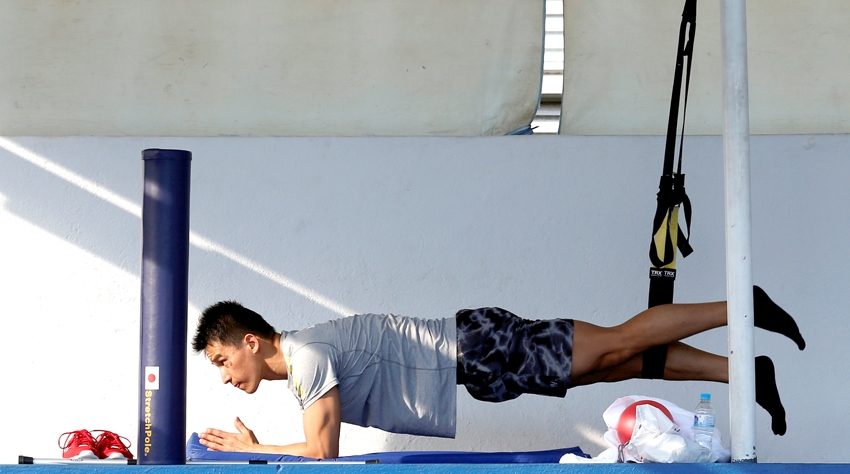You are viewing 1 of your 1 free articles. For unlimited access take a risk-free trial
Strength training for athletes: free or machine weights?
Many athletes believe that free weights are superior to machines for building strength. But does the science support this notion and how can you make machine weight training better? Andrew Hamilton looks at the evidence
There’s no doubt that performed correctly, resistance training is a thoroughly desirable component of any athlete’s training regime. There’s now overwhelming evidence that regular resistance training can boost muscle mass and strength, leading to improved core strength, a reduction in injury risk and most importantly, significantly improved sports performance(1).
What resistance training?
Take a look back and you’ll see that the nature of resistance training has changed considerably over the past 90 years. Almost all of the early books on weight-training techniques included only free weight exercises, with not a machine in sight. In fact it wasn’t really until the late 1970s and early 80s that machine-based resistance exercises started to make a real appearance. This was no doubt due to a combination of factors; increased gym usage by relative weight training novices, the reduced cost of machine manufacturing and the growth of the ‘convenience culture’, which so dominates our lives today.
This trend was accelerated by sports equipment companies such as Nautilus, who applied the science of biomechanics to produce machines that were highly efficient at isolating and working specific muscle groups. With increasing technology and ever lower manufacturing costs, the sophistication, complexity and universal acceptance of single station resistance machines as the way forward became unstoppable.
Over the last 20 years or so, many gyms have come to rely nearly exclusively on machines to provide resistance training, with free-weights all too often relegated to a cramped corner of the gym – and that’s if there are any at all! This trend is partly explained by convenience and cost; gyms equipped solely with machines require less supervision, and therefore fewer staff. There’s also a health and safety aspect; used incorrectly, free weight training is more likely to lead to injury, with all the legal ramifications that might follow!
Superior training tool: machines or free weights?
If machines get the job done and are safer to use, is there any point in using free weights? Free weight advocates argue strongly that there is. The logic is that the human body has evolved over millions of years into a highly intelligent and efficient machine. As part of that development, our central and peripheral nervous systems have evolved to protect us from unwanted injury by providing natural sequences of muscle recruitment and movement that share the load across as many muscles and joints as possible. This allows muscles to operate as teams, each working muscle making its contribution to any movement at its optimum length, tension and orientation.
Although you don’t consciously have to think about this as you lift that heavy suitcase onto a luggage rack, lift a dumbbell above your head, or climb over a style while you enjoy a country walk, your brain is ferociously processing information and sending the right electrical impulses to exactly the right muscle motor units at exactly the right time so that by optimally sharing the load across muscles and joints, you can execute these movements efficiently and safely. However, this is stark contrast to most resistance machines found in the gym, where both the axis and plane of the movement is restricted and pre-determined by the machine and its design. And some argue that this restricted pattern of movement comes with costs.
1D vs. 3D
Let’s use a common machine movement as an example – the seated chest. To work your chest and triceps, you apply force against the handles, which are connected by levers, pulleys and a chain or strap system to the weights on the weight stack. In most of these machines, the handles are pivoted and are confined to move in only one direction. This means the movement at any one point in the range of motion is one-dimensional; ie wherever you are in the lifting phase, there’s only one direction in which the handles will move.
However, the body’s natural sequences of muscle recruitment and movement are designed to share the load across as many muscles and joints as possible, and function in three dimensions: up/down, backwards/forwards and left/right. This is more closely replicated with free weights. When you perform the ‘free weight’ movement equivalent of the machine chest press (eg dumbbell or barbell chest press), the overall direction of motion is also 1-dimensional. However, the sequences of muscle recruitment are actually operating in three dimensions, not only to control the movement and prevent excessive sideways or backwards/forwards motion, but also to find the optimum arc of motion in order to share the load as efficiently as possible across the muscles and joints.
Being able to operate muscles and joints in 3 degrees of dimensional freedom confers a theoretical advantage over restricted 1-dimensional movement. Research has demonstrated that our nervous systems can not only recruit a specific muscle needed to perform a particular movement pattern, but can also selectively recruit specific motor units, or segments within a given muscle and rotate them as fatigue sets in. This is known as asynchronous stimulation and is an important mechanism for conserving energy and preventing unwanted overload in specific tissues(2).
Free weights and 3D
Given that ‘free’ or 3-dimensional movements enable load sharing and asynchronous stimulation, it’s hardly surprising to find that the bar or dumbbell path in a free weight chest press is very different to that in most machine chest presses. Firstly, the free movement path tends to describe an arc, whose exact geometry depends on the individual biomechanics of the lifter. Secondly, were you to very carefully analyse the exact bar/dumbbell path, you would discover that even the most elite lifters in the world would never replicate the same path in two consecutive reps!
Contrast this with a machine chest press movement. Every single rep follows the exact same pathway as the last, a pathway that is unlikely to be biomechanically optimal for the lifter. The same motor units will fire in the same order regardless of fatigue, and because of the lack of asynchronous stimulation, those units most suited to working in the ‘superimposed’ pattern dictated by the machine will experience fatigue much sooner than when performing the same exercise with free weights.
The research
Given the theoretical physiological advantages that free-weight resistance training appears to offer over machine resistance training, a natural question to ask is whether an athlete training with free weights can expect superior strength gains – particularly sports-specific strength gains - when using free weights? Surprisingly perhaps, there’s very little research data in the literature on this topic. In a very recent study published just a few weeks ago however, researchers compared the effects of using machines or free weights in a group of older exercisers(3) In this study, the subjects were split into two groups. Both groups trained twice a week for 26 weeks, working a mix of upper and lower body muscles but one key difference:
- One group trained exclusively with free weights performing squats, bench presses, bent-over rows, biceps curls, lying triceps presses.
- The second group trained exclusively with machine weights, performing chest presses, leg presses, upper back rows, biceps cable curls, triceps cable extensions.
The results showed that for leg and triceps strength, there was clear advantage for free weight training. The % gains for the free vs. machine groups were (113% vs. 44% for leg strength for and triceps strength, 89.0% vs. 28.3%. Another win for free weights was that although this mode required higher demands for safety, the subjects reported higher levels of fun and motivation when training – and a greater benefit in their day-to-day activities.
Another very recent study compared the effects of performing squats using a Smith machine to those using free weights and to free weight squats on an unstable surface (wobble board)(4). It found that all training groups showed similar improvement in muscle thickness and rate of force development (explosive power). However, when it came to countermovement jump (see figure 1) performance and 10-rep maximum, training with free weights on the wobble board conferred a significant advantage compared to Smith machine training. One possible explanation for this observation is that the unstable surface a) was more effective in recruiting muscle motor units and b) more closely replicated the motor neuron firing patterns required for a manoeuvre such as the countermovement jump.
Figure 1: Countermovement jump

The five phases of the countermovement jump - where the aim is to jump as high as possible - are shown along with velocity and force curves in each stage.
In a 2010 study, researchers compared chest muscle strength gains in women over a 3-month period training three times per week using the following(5):
- Free weights.
- A supine (lying on back) bench press machine.
- A vertical bench press machine.
It found that all three modes of training resulted in strength gains, but these gains were not significantly different among the training modes. What was apparent was that the gains were specific – ie those that trained with free weights scored less well when tested for strength on the machines and vice-versa. This neatly underlines the concept of specificity of strength training – ie that any strength training should mimic the movement pattern of your sport (or aspect of that sport you are trying to improve) as closely as possible. For a more detailed look at specificity of strength training and matching patterns of movement, James Marshall’s excellent article on dry-land training for swimmers and triathletes makes for very informative reading – whatever your sport!
Summary and practical advice
In theory, free weight resistance training should offer physiological benefits over machine training, and the evidence to date is that is in some respects, it might do. The problem however is that the volume of research on this topic is very limited, so it’s hard to draw firm conclusions. What we can say is that both machine and free weight training will produce significant strength gains, which can positively affect your sports performance. On balance however, and given the choice, free weight training might confer a slight advantage, especially where it can be adapted to closely replicate a sport-specific movement. But if you are limited to machine use for whatever reason, the tips below are worth bearing in mind!
Practical advice for machine use
- Avoid using machines that are ergonomically incorrect for your body. If you find that you just can’t seem to get a machine to fit your dimensions or to ‘feel’ right, no matter how you adjust it, the chances are the it’s just not biomechanically suited to your body. Leave it out and if possible replace it either with a cable or, better still, a free-weight exercise.
- Don’t let the controlled 1-dimensional movement provided by a machine tempt you into trying to perform an excessive range of movement. Challenging joints with an extreme range of movement under load can stretch the joint capsule and ligaments, leading to an increased risk of future injury. Examples of this are lat pull over and leg press machines, which can stretch and destabilise the shoulder and spinal/sacrum joints respectively.
- Try mixing up or alternating your machine training with simple callisthenic-type exercises using body weight – eg chins, dips, press ups, sissy squats, unweighted lunges etc. As well as adding variety, these types of exercise will result of greater neural activation of the muscle motor units.
References
- Int J Sports Physiol Perform. 2006 Jun;1(2):74-83
- IEEE Trans Neural Syst Rehabil Eng. 2015 Nov;23(6):964-72.
- Exp Gerontol. 2019 Apr 10;122:15-24.
- PLoS One. 2019 Apr 1;14(4):e0214302
- J Strength Cond Res. 2010 Oct;24(10):2779-84
Newsletter Sign Up
Testimonials
Dr. Alexandra Fandetti-Robin, Back & Body Chiropractic
Elspeth Cowell MSCh DpodM SRCh HCPC reg
William Hunter, Nuffield Health
Newsletter Sign Up
Coaches Testimonials
Dr. Alexandra Fandetti-Robin, Back & Body Chiropractic
Elspeth Cowell MSCh DpodM SRCh HCPC reg
William Hunter, Nuffield Health
Keep up with latest sports science research and apply it to maximize performance
Today you have the chance to join a group of athletes, and sports coaches/trainers who all have something special in common...
They use the latest research to improve performance for themselves and their clients - both athletes and sports teams - with help from global specialists in the fields of sports science, sports medicine and sports psychology.
They do this by reading Sports Performance Bulletin, an easy-to-digest but serious-minded journal dedicated to high performance sports. SPB offers a wealth of information and insight into the latest research, in an easily-accessible and understood format, along with a wealth of practical recommendations.
*includes 3 coaching manuals
Get Inspired
All the latest techniques and approaches
Sports Performance Bulletin helps dedicated endurance athletes improve their performance. Sense-checking the latest sports science research, and sourcing evidence and case studies to support findings, Sports Performance Bulletin turns proven insights into easily digestible practical advice. Supporting athletes, coaches and professionals who wish to ensure their guidance and programmes are kept right up to date and based on credible science.













